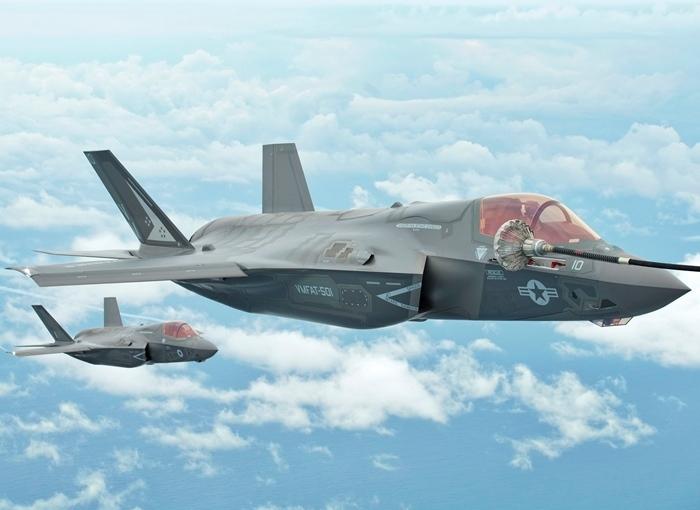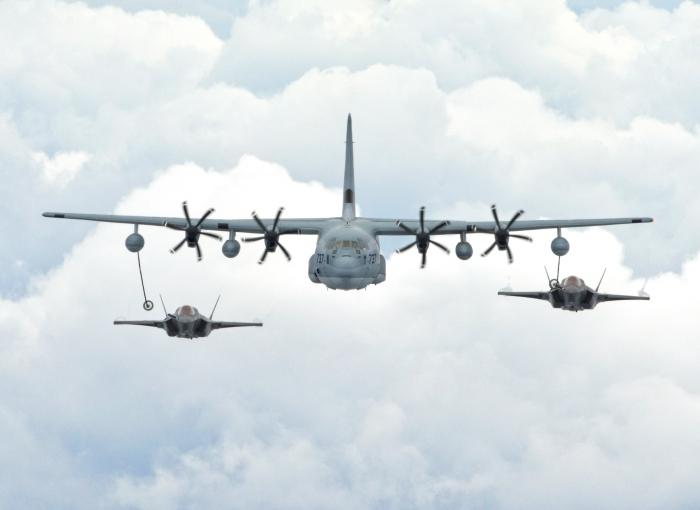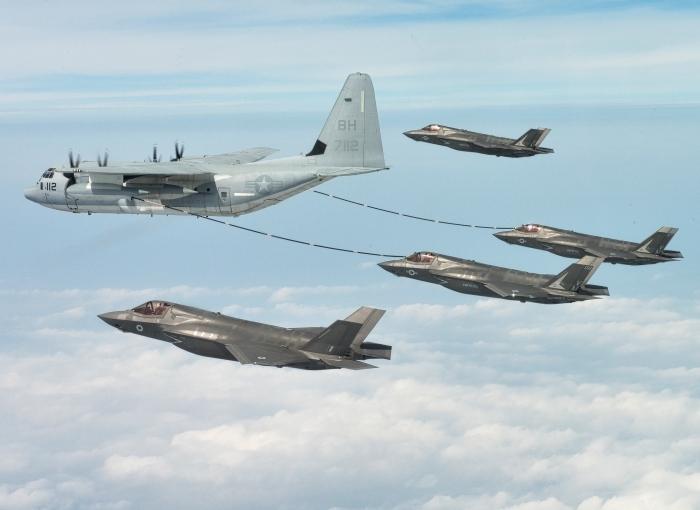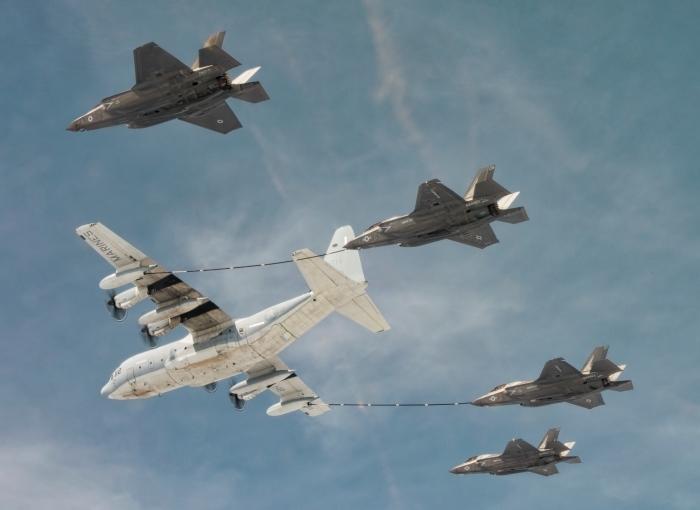2015-06-19 F-35′s from the 56th Fighter Wing are seen with two KC-135′s for an aerial refueling mission over Arizona.
Credit Video: 56th Fighter Wing Public Affairs
6/5/15
And the perspective from MCAS Beaufort:
Fueling a fighter jet mid-mission isn’t as easy as exiting a highway to top off your tank. It’s really quite a sight to see, as these amazing shots below, captured during recent flight operations at MCAS Beaufort, South Carolina, prove.
“The main reason military aircraft use aerial refueling is to extend the mission radius of the jet,” explains retired U.S. Marine Corps F/A-18 pilot Rolf “Bugsy” Siegel. “For long-range missions, a fighter will take off from their operating base, meet a tanker en-route to top-off, enter enemy territory to perform their mission, and then return back to the tanker to refuel again prior to flying back to land at their operating base.”
Without aerial refueling, many of the long-range missions performed by the fighter jets of today, and those of tomorrow like the F-35, wouldn’t be possible. The same can be said for cross-country, or even trans-ocean flights, for cargo or personnel transit – using a tanker aircraft, you can essentially get a squadron of fighters from where you are to anywhere you need to go. Air refueling is also used for long range missions to deploy combat aircraft from the continental U.S. to overseas locations.
But how do they do it? How does an F-35, shooting through the sky at 240 knots (275 MPH), fly up beside a KC-130J or another tanker and plug in to a 93-foot fuel hose via a circular “basket” only about a foot-and-a-half in diameter? The precision of the task itself seems daunting. So here’s the breakdown of how aerial refueling works.
Rendezvous and Pre-Contact
The first step to aerial refueling is finding a rendezvous point.
“In some cases, this may be somewhere over the ocean if a squadron were transferring to an oversea base,” explains Bugsy, “or it could be a rendezvous point or tanker track normally published in the Air Tasking Order if the aircraft was performing air refueling as part of their mission.”
In the case of the F-35, it’s usually either a point somewhere over the middle of the U.S., when the aircraft are flying cross-country for a base transfer, or somewhere near one of the many training bases. Once the F-35 pilot locates the tanker, they make contact with the pilot and initiate intercept. The flight lead will join closest to the tanker while the wingmen line up in an echelon formation. Next, while the planes are in what is called “pre-contact,” the fighter pilot will adjust mission systems to ensure their radar isn’t interfering with the tanker. In legacy fighters, this involves pushing a few buttons and turning a few knobs. But in the F-35, explains F-35 Contract Instructor Pilot Oscar “Speedy” Alvarez, “it’s simply a matter of selecting the “pre-contact” option selection button (OSB) on the cockpit’s touchscreen, which puts the radar into standby mode.”
Refueling
Once in position, and still in communication with the tanker pilot, the F-35 pilot selects the “Refuel” OSB from his flight control display. On the F-35B and F-35C variants, which use a probe-and-drogue system, this will deploy the refueling probe so that it can connect to the basket on the end of the hose. Once contact is made, the fighter pilot will move the basket up about 10 feet or so and the refueling begins.
For the F-35A variant, which uses a flying boom aerial refueling, the pilot flies in a tight formation with the tanker. An operator at the back of the tanker and the F-35 pilot work together to ensure the boom aligns with the aircraft and is inserted directly into the fuel tank opening.
From there, it’s just a simple matter of starting the fuel flow.
Training
Aerial refueling is “part of the basic training pilots go through,” Speedy says. Before going on a refueling mission, the pilots have already been through most of the learning syllabus at the Pilot Training Center, and have already flown the jets to get some experience. After a lecture explaining the basics of aerial refueling mission planning, aircraft limitations, tanker rendezvous and departure procedures and tanker-specific capabilities, the pilots are sent back to their squadrons to give it a try.
“One of the hardest parts of aerial refueling is learning to fly the probe into the basket smoothly. At times when there is turbulence it’s not as easy as it looks as the basket is relatively light and moves around,” explains Bugsy. “It takes some practice to learn to fly the probe into the basket without too much closure [how fast you are approaching the basket] or angular rates (up/down, left/right) which could damage the basket or the probe on the aircraft.”
Pilots have to complete six “plugs” to achieve their initial “qual” – or qualification – for aerial refueling.






